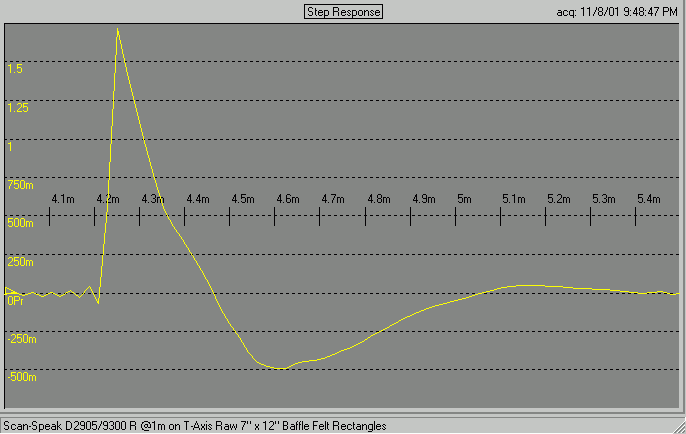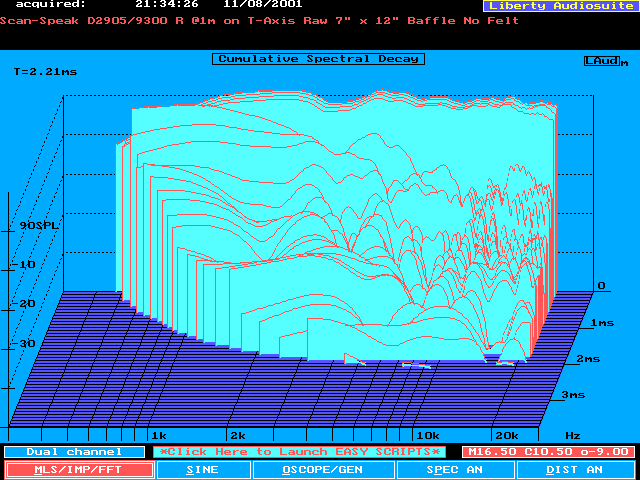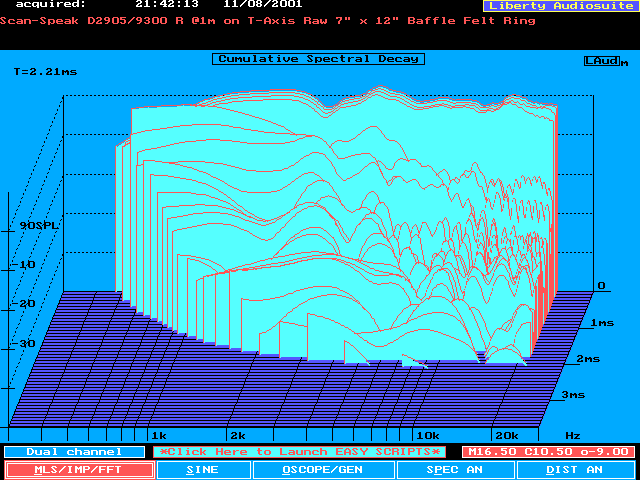November 10th, 2001
One question frequently arises on discussion boards about the use of felt for diffraction reduction purposes. This is often in reference to the commonly found "felt" rings made specifically for use on tweeters. However, these "felt" rings are not wool felt, they are synthetic, much less effective than real wool felt. I had briefly tried these, only to find that they did not help in the way intended. There was a change in the sound, but this change is not optimal.
I've done quite a bit of testing with various types and thicknesses of real wool felt and often suggest it's use. Given the frequency of questions regarding felt rings I decided to re-do some tests and post the results. My conclusion remains the same regarding the use of rings in particular.
Consider the graph below. It shows the measured on-axis response of a Scan-Speak D2905/9300 tweeter, in a small M/T module (7" x 12" baffle), mounted 7/8" offset laterally from the centerline, with the module seated flush on top of a woofer box (12" x 25.5" baffle), with and without felt treatment. One of the measurements is the case of a typical 1/8" thick "felt" ring (yellow), a second one is for the case of 1/2" real wool felt (AES Type F-13) cut into blocks and placed strategically around the tweeter on three sides (red) and the third one is for the untreated case (blue).

Note the small extension increase at marker 1 (of little consequence for a tweeter) in the graph above. The other markers show the detrimental effects of the thin felt ring. In this particular case (on-axis at least) no felt is better than the felt ring. The ring does nothing below 2khz (marker 2) while adding 1-2db peaks or dips at several frequencies (markers 3-5).
Marker 5 is interesting in particular. Usually there is little change above 10khz. But the ring is so close to the dome that the reflection from the inside of the ring is enough to cause the response change in the higher frequencies. I noted this with the felt blocks as well, when I placed it close to the dome. My recommendation is to not have any sort of treatment closer then the edge of the driver mounting plate, or at least not much closer. I do have a strip which covers a small portion of the faceplate of the tweeter, but this is because it is placed between the tweeter and midrange unit (as it contributes to diffraction of the tweeter signal as well) and must cover it just a little.

In the time domain graph (above), we see that all three start off identically, but by marker 1 the felt ring (yellow) is already showing significant deviation from the other two cases, and varies more from ideal. The ideal would be a nearly vertical rise, followed by a very steep return with overshoot to the negative side (which all three approximate well), finally settling quickly and smoothly to the zero line from below. The peaks/dips are indicative of driver response irregularities, any baffle vibration and diffraction effects. The best response is, again, from the use of the the felt blocks (the red graph).
The step responses (below) are interesting as well (overlays are not possible with LAUD for step response). The step response shows how the driver will act in response to a step input. Ideally it should go to the step output level immediately and stay there (like a DC offset). However, all drivers lag in the time to get to the position, overshoot, and settle with some ringing.
The first one shows the response for the untreated case, the second one is for the felt blocks and the third one is for the felt ring. Each one has a small break away at about 1.3 msec. But look at the third one, the felt ring. It has an additional break at 1.4 msec, where it's slope changes momentarily, before continuing as before. The ideal for this portion would be a perfectly straight line. None of the three do this, but the first two are not bad. The felt ring again causes additional deviation from ideal unlike the other two.



Finally we have the Cumulative Spectral Decay (CSD, or Waterfall) plots. Looking first at the case of no felt treatment (below), we see the typical diffraction signature of this size baffle in the 2-4khz area (a medium dip), with peaks on both sides. Other areas are impacted (this is a very flat driver on an IEC baffle), but not to a large extent.

Now look at the graph for the felt ring. Nearly every peak and dip is more exagerated. There are small areas that look like improvements, but there's little improvement overall. It can be argued that this is worse than no felt at all.

This leaves the felt blocks. The falloff appears to happen quicker, with fewer of what look like resonant ridges, which are most likely the reflections from the baffle edges and from the midrange driver (which is also very close). Overall it's less clear with the CSD than with the frequency response plots, but the trend of a cleaner output is supported.

My conclusion is that the use of (synthetic) felt rings may be useful if one has a system and cannot make other changes (such as crossover mods for the tweeter) and testing improves the perceived sound. The differences with them are audible. But if the best response is desired and measurements are available for use in a crossover design, use real wool felt (SAE Type F-11 or F-13) available from many sources.